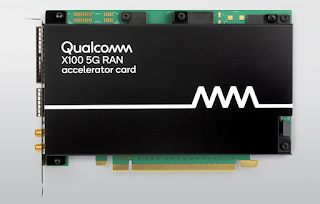Hewlett Packard Enterprise (HPE) will deliver 5G distributed units powered by Qualcomm Technologies X100 5G RAN inline accelerator card and its HPE ProLiant DL110 Gen10 Plus Telco Server.
The Qualcomm X100 5G RAN accelerator card, which leverages a combination of DSPs and ARM CPUs, offloads Layer 1 and Layer 2 MAC functionality, including compute-intensive 5G baseband processing.
HPE's 5G RAN virtualized distributed unit (vDU) solution is designed to support up to four high-performance accelerator cards in a small footprint 1U server, which lowers power consumption, even while supporting dense 5G mid-band and massive MIMO use cases.
“HPE is looking forward to collaborating with Qualcomm Technologies to help address the rigorous and ever-changing demands of 5G,” said Tom Craig, general manager and vice president, communications technology group, Hewlett Packard Enterprise. “Our industry-leading HPE carrier-grade infrastructure integrated with Qualcomm Technologies’ innovative technology will further benefit our customers as they expand the deployment of their 5G networks.”
“We are excited for the opportunity to work with HPE to further the capabilities and efficiencies of 5G virtualized networks,” said Durga Malladi, senior vice president and general manager, 5G, mobile broadband and infrastructure, Qualcomm Technologies, Inc. “Through our collaboration with HPE, we are able to deliver enhanced, powerful and reliable 5G experiences to consumers.”
http://www.qualcomm.com/products/5g
Qualcomm intros 5G DU accelerator card
Qualcomm introduced its 5G DU X100 PCIe inline accelerator card with concurrent Sub-6 GHz and mmWave baseband support.
The accelerator card is designed to ease of deployment with O-RAN fronthaul and 5G NR layer 1 High (L1 High) processing. It plugs into standard Commercial-Off-The-Shelf (COTS) servers to offload CPUs from latency-sensitive and compute-intensive 5G baseband functions such as demodulation, beamforming, channel coding, and Massive MIMO computation needed for high-capacity deployments. For use in public or private networks, this accelerator card aims to give carriers the ability to increase overall network capacity and fully realize the transformative potential of 5G.Qualcomm targets 5G RAN platforms

Vodafone and Qualcomm collaborate on O-RAN blueprint

















